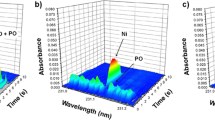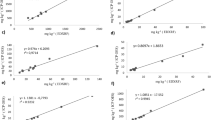Abstract
Recently, consumption of collagen-based foodstuffs has grown significantly, especially collagen hydrolysate, used as a dietary supplement. Information available on the content of essential and toxic elements in these products, however, is incipient. This study provides a novel assessment of the mineral profile (Al, As, Ca, Cd, Co, Cr, Fe, K, Mg, Mn, Na, P, S, V, and Zn) of collagen hydrolysate and gelatin by inductively coupled plasma optical emission spectrometry (ICP OES) and mass spectrometry (ICP-MS). Thirty-two samples were digested with diluted HNO3 and H2O2, using an efficient microwave-assisted decomposition method (11.9% residual carbon content). The methodology was validated using certified reference materials and recovery tests, with agreement between the determined and certified/added concentration values (85–124%), and relative standard deviation of up to 18%. The limits of quantification ranged from 0.33 μg kg−1 (Cd) to 24 mg kg−1 (Na). The contributions of collagen hydrolysate to the Dietary Reference Intake values of the evaluated minerals were low, with the highest value being 13.5% for the Adequate Intake of Cr. The findings of Permitted Daily Exposure suggest that there is no risk of contamination with As and Cd by consuming this food supplement. Concentrations of Cr, Mn, and Zn reported on product labels agreed with experimental results. For Na, these values differed, indicating that a more rigorous quality control of collagen hydrolysate is necessary, in view of the health problems caused by excessive consumption of this element.
Graphical abstract

Similar content being viewed by others
Availability of Data and Material
Data will be made available on request.
Code Availability
Not applicable.
References
Agência Nacional de Vigilância Sanitária – ANVISA (2018) Instrução Normativa - IN N° 28, de 26 de julho de 2018. http://www.in.gov.br/materia/-/asset_publisher/Kujrw0TZC2Mb/content/id/34380639/do1-2018-07-27-instrucao-normativa-in-n-28-de-26-de-julho-de-2018-34380550. Accessed 2 March 2020
Analytical Methods Committee (1987) Recommendations for the definition, estimation and use of the detection limit. Analyst 112(2):199–204. https://doi.org/10.1039/an9871200199
Araújo GCL, Gonzalez MH, Ferreira AG, Nogueira ARA, Nobrega JA (2002) Effect of acid concentration on closed-vessel microwave-assisted digestion of plant materials. Spectrochim Acta B 57:2121–2132. https://doi.org/10.1016/S0584-8547(02)00164-7
Arumugam GKS, Sharma D, Balakrishnan RM, Ettiyappan JBP (2018) Extraction, optimization and characterization of collagen from sole fish skin. Sustain Chem Pharm 9:19–26. https://doi.org/10.1016/j.scp.2018.04.003
Association of Official Analytical Chemists – AOAC (2019) Official methods of analysis, 21st edn. AOAC International, Arlington
Barros JAVA, de Souza PF, Schiavo D, Nóbrega JA (2016) Microwave-assisted digestion using diluted acid and base solutions for plant analysis by ICP OES. J Anal At Spectrom 31(1):337–343. https://doi.org/10.1039/c5ja00294j
Bizzi CA, Flores EMM, Barin JS, Garcia EE, Nóbrega JA (2011) Understanding the process of microwave-assisted digestion combining diluted nitric acid and oxygen as auxiliary reagent. Microchem J 99(2):193–196. https://doi.org/10.1016/j.microc.2011.05.002
Bizzi CA, Flores ELM, Nóbrega JA, Oliveira JSS, Schmidt L, Mortari SR (2014a) Evaluation of a digestion procedure based on the use of diluted nitric acid solutions and H2O2 for the multielement determination of whole milk powder and bovine liver by ICP-based techniques. J Anal At Spectrom 29(2):332–338. https://doi.org/10.1039/c3ja50330e
Bizzi CA, Nóbrega JA, Barin JS, Oliveira JSS, Schmidt L, Mello PA, Flores EMM (2014b) Effect of simultaneous cooling on microwave-assisted wet digestion of biological samples with diluted nitric acid and O2 pressure. Anal Chim Acta 837:16–22. https://doi.org/10.1016/j.aca.2014.05.051
Cebi N, Dogan CE, Mese AE, Ozdemir D, Arıcı M, Sagdic O (2019) A rapid ATR-FTIR spectroscopic method for classification of gelatin gummy candies in relation to the gelatin source. Food Chem 277:373–381. https://doi.org/10.1016/j.foodchem.2018.10.125
Council for Responsible Nutrition – CRN USA (2018) Consumer survey on dietary supplements: new data reaffirm trust and confidence in industry, reveal modern trends and habits of American Consumers. https://www.crnusa.org/CRNConsumerSurvey/. Accessed 21 August 2019
da Silva MJ, Paim APS, Pimentel MF, Cervera ML, de la Guardia M (2010) Determination of mercury in rice by cold vapor atomic fluorescence spectrometry after microwave-assisted digestion. Anal Chim Acta 667:43–48. https://doi.org/10.1016/j.aca.2010.04.016
da Silva IJS, Paim APS, da Silva MJ (2018) Composition and estimate of daily mineral intake from samples of Brazilian rice. Microchem J 137:131–138. https://doi.org/10.1016/j.microc.2017.10.006
da Silva IJS, Lavorante AF, Paim APS, da Silva MJ (2020) Microwave-assisted digestion employing diluted nitric acid for mineral determination in rice by ICP OES. Food Chem 319:126435. https://doi.org/10.1016/j.foodchem.2020.126435
Eurachem (2014) The fitness for purpose of analytical methods: a laboratory guide to method validation and related topics, Second Edition. https://www.eurachem.org/images/stories/Guides/pdf/MV_guide_2nd_ed_EN.pdf. Accessed 8 March 2020
Gauza-Włodarczyk M, Kubisz L, Włodarczyk D (2017) Amino acid composition in determination of collagen origin and assessment of physical factors effects. Int J Biol Macromol 104:987–991. https://doi.org/10.1016/j.ijbiomac.2017.07.013
Gouveia ST, Silva FV, Costa LM, Nogueira ARA, Nóbrega JA (2001) Determination of residual carbon by inductively-coupled plasma optical emission spectrometry with axial and radial view configurations. Anal Chim Acta 445(2):269–275. https://doi.org/10.1016/S0003-2670(01)01255-7
He FJ, Tan M, Ma Y, MacGregor GA (2020) Salt reduction to prevent hypertension and cardiovascular disease: JACC state-of-the-art review. J Am Coll Cardiol 75(6):632–647. https://doi.org/10.1016/j.jacc.2019.11.055
Jing M, Ni Y, Wang Y, Zhang Z (2012) Determination of chromium in gelatin capsules using an Agilent 7700x ICP-MS. Agilent Technologies, Application note, Pharmaceutical. http://hpst.cz/sites/default/files/attachments/5991-1531en-determination-chromium-gelatin-capsules-using-agilent-7700x-icp-ms.pdf Accessed 7 March 2020
Linsinger T (2010) Application Note 1: comparison of a measurement result with the certified value, Revision 3. https://crm.jrc.ec.europa.eu/graphics/cms_docs/erm1_english.pdf. Accessed 8 March 2020
Mesko MF, Crizel MG, Novo DLR, Hartwig CA, Rondan FS, Bizzi CA (2020) New and feasible method for total phosphorus and sulfur determination in dietary supplements by ion chromatography. Arab J Chem 13(1):2076–2083. https://doi.org/10.1016/j.arabjc.2018.03.006
Moraes DP, Bizzi CA, Nóbrega JA, Flores EMM, Nogueira ARA, Barin JS, Mesko MF (2019) Preparo de amostras assistido por radiação micro-ondas. In: Krug JF, Rocha FRP (eds) Métodos de preparo de amostras para análise elementar, 2nd edn. EditSBQ, São Paulo, pp 299–369
National Institutes of Health – NIH (2020) Office of Dietary Supplements. Food and Nutrition Board, Institute of Medicine, National Academy of Sciences. Nutrient Recommendations: Dietary Reference Intakes (DRI), DRI Tables and Activities Update.https://ods.od.nih.gov/Health_Information/Dietary_Reference_Intakes.aspx. Accessed date: 1 March 2020
Nelson DL, Cox MM (2011) Princípios de Bioquímica de Lehninger, 5th edn. Artmed, Porto Alegre (Chapters 3 and 4)
Olivieri AC (2015) Practical guidelines for reporting results in single- and multi-component analytical calibration: a tutorial. Anal Chim Acta 868:10–22. https://doi.org/10.1016/j.aca.2015.01.017
Ortolan MCAB, Biondo-Simões MLP, Baroni ERV, Auersvald A, Auersvald LA, Montemor Netto MR, Biondo-Simões R (2013) Influence of aging on the skin quality of white-skinned women: the role of collagen, elastic material density, and vascularization. Rev Bras Cir Plást 28(1):41–48 http://www.scielo.br/pdf/rbcp/v28n1/en_08.pdf
Paul C, Leser S, Oesser S (2019) Significant amounts of functional collagen peptides can be incorporated in the diet while maintaining indispensable amino acid balance. Nutrients 11(5):1–9. https://doi.org/10.3390/nu11051079
Pereira RM, Crizel MG, Novo DLR, dos Santos CMM, Mesko MF (2019) Multitechnique determination of metals and non-metals in sports supplements after microwave-assisted digestion using diluted acid. Microchem J 145:235–241. https://doi.org/10.1016/j.microc.2018.10.043
Pinheiro FC, Babos DV, Barros AI, Pereira-Filho ER, Nóbrega JA (2019) Microwave-assisted digestion using dilute nitric acid solution and investigation of calibration strategies for determination of As, Cd, Hg and Pb in dietary supplements using ICP-MS. J Pharm Biomed Anal 174:471–478. https://doi.org/10.1016/j.jpba.2019.06.018
Quináia SP, Nóbrega JA (1999) Direct determination of chromium in gelatine by graphite furnace atomic absorption spectrophotometry. Food Chem 64:429–433. https://doi.org/10.1016/S0308-8146(98)00114-9
QY Research Report (2018) Global collagen peptides market research report. http://www.qyresearchreport.com/global-collagen-peptides-market-research-report-2018-detailed.html?utm_source=rushikesh. Accessed 22 November 2020
Ribeiro FAL, Ferreira MMC, Morano SC, da Silva LR, Schneider RP (2008) Planilha de validação: Uma nova ferramenta para estimar figuras de mérito na validação de métodos analíticos univariados. Quim Nova 31(1):164–171. https://doi.org/10.1590/S0100-40422008000100029
Rocha FRP, Nóbrega JA, Kamogawa MY (2019) Fundamentos do preparo de amostras. In: Krug JF, Rocha FRP (eds) Métodos de preparo de amostras para análise elementar, 2nd edn. EditSBQ, São Paulo, pp 19–40
Santos DCMB, Carvalho LSB, Lima DC, Leão DJ, Teixeira LSG, Korn MGA (2014) Determination of micronutrient minerals in coconut milk by ICP OES after ultrasound-assisted extraction procedure. J Food Compos Anal 34(1):75–80. https://doi.org/10.1016/j.jfca.2014.02.008
Silva FV, Trevizan LC, Silva CS, Nogueira ARA, Nóbrega JA (2002) Evaluation of inductively coupled plasma optical emission spectrometers with axially and radially viewed configurations. Spectrochim Acta B 57(12):1905–1913. https://doi.org/10.1016/S0584-8547(02)00176-3
Sobihah NN, Zaharin AA, Nizam MK, Juen LL, Kyoung-Woong K (2018) Bioaccumulation of heavy metals in maricultured fish, Lates calcarifer (Barramudi), Lutjanus campechanus (red snapper) and Lutjanus griseus (grey snapper). Chemosphere 197:318–324. https://doi.org/10.1016/j.chemosphere.2017.12.187
Tarantino TB, Barbosa IS, Lima DC, Pereira MG, Teixeira LSG, Korn MGA (2017) Microwave-assisted digestion using diluted nitric acid for multi-element determination in rice by ICP OES and ICP-MS. Food Anal Methods 10(4):1007–1015. https://doi.org/10.1007/s12161-016-0658-4
United States Environmental Protection Agency – US EPA (2014) Method 6020B (SW-846): inductively coupled plasma-mass spectrometry. Update V, Revision 2. https://www.epa.gov/sites/production/files/2015-12/documents/6020b.pdf. Accessed 22 February 2020
United States Environmental Protection Agency – US EPA (2018) Method 6010D (SW-846): inductively coupled plasma optical emission spectrometry. Update VI, Revision 5. https://www.epa.gov/sites/production/files/2015-12/documents/6010d.pdf. Accessed 12 December 2019
United States Pharmacopeia – USP (2012) General Chapter 2232: Elemental Contaminants in Dietary Supplements, 38 (3), May – June. https://www.uspnf.com/sites/default/files/usp_pdf/EN/USPNF/elemental_contaminants_in_dietary_supplements_m5291_3-26-2012.pdf. Accessed 1 March 2020
Yazaki M, Ito Y, Yamada M, Goulas S, Teramoto S, Nakaya M, Ohno S, Yamaguchi K (2017) Oral ingestion of collagen hydrolysate leads to the transportation of highly concentrated Gly-Pro-Hyp and its hydrolyzed form of Pro-Hyp into the bloodstream and skin. J Agric Food Chem 65(11):2315–2322. https://doi.org/10.1021/acs.jafc.6b05679
Yilmaz MT, Kesmen Z, Baykal B, Sagdic O, Kulen O, Kacar O, Yetim H, Baykal AT (2013) A novel method to differentiate bovine and porcine gelatins in food products: nanouplc-ESI-Q-TOF-MSE based data independent acquisition technique to detect marker peptides in gelatin. Food Chem 141(3):2450–2458. https://doi.org/10.1016/j.foodchem.2013.05.096I
Acknowledgements
Instrumental support provided by Agilent Technologies, Analítica, Milestone and Thermo Scientific is gratefully acknowledged. We are also thankful to Empresa Brasileira de Pesquisa Agropecuária (EMBRAPA—Pecuária Sudeste) and Centro de Apoio à Pesquisa (CENAPESQ—UFRPE) for the use of physical facilities and analytical equipment, and to M.Sc. Fernanda Costa Pinheiro and M.Sc. Julymar Marcano de Higuera from the Group for Applied Instrumental Analysis, Federal University of São Carlos, for their assistance with ICP-MS measurements. The English text of this paper has been revised by Sidney Pratt, Canadian, MAT (The Johns Hopkins University), RSAdip—TESL (Cambridge University).
Funding
This study was funded by the Conselho Nacional de Desenvolvimento Científico e Tecnológico (CNPq) (grant number 147727/2018-9), Fundação de Amparo à Ciência e Tecnologia do Estado de Pernambuco (FACEPE) (grant number APQ-1017-1.06/15), and Fundação de Amparo à Pesquisa do Estado de São Paulo (FAPESP). We also would like to express our gratitude to the Instituto Nacional de Ciências e Tecnologias Analíticas Avançadas (INCTAA), CNPq (grant number 465768/2014-8), and FAPESP (grant number 2014/50951-4) for the financial support. Also, financial support for this was given by Núcleo de Química Analítica Avançada de Pernambuco (NUQAAPE/FACEPE) (grant number APQ-0346-1.06/14).
Author information
Authors and Affiliations
Contributions
Iago J. S. da Silva: conceptualization, methodology, validation, formal analysis, investigation, data curation, writing—original draft, visualization; Matheus L. de Mello: conceptualization, methodology, validation, investigation, writing—review and editing, visualization; André F. Lavorante: writing—review and editing, visualization; Ana P. S. Paim: conceptualization, resources, writing—review and editing, visualization, supervision; Joaquim A. Nóbrega: methodology, resources, writing—review and editing, visualization, supervision, project administration, funding acquisition; Maria J. da Silva: resources, writing—review and editing, visualization, supervision, project administration, funding acquisition.
Corresponding authors
Ethics declarations
Ethics Approval
This article does not contain any studies with human participants or animals performed by any of the authors.
Informed Consent
Not applicable.
Conflict of Interest
Iago J. S. da Silva declares that he has no conflict of interest. Matheus L. de Mello declares that he has no conflict of interest. André F. Lavorante declares that he has no conflict of interest. Ana P. S. Paim declares that she has no conflict of interest. Joaquim A. Nóbrega declares that he has no conflict of interest. Maria J. da Silva declares that she has no conflict of interest.
Additional information
Publisher’s Note
Springer Nature remains neutral with regard to jurisdictional claims in published maps and institutional affiliations.
Supplementary Information
ESM 1
(DOCX 40 kb)
Rights and permissions
About this article
Cite this article
da Silva, I.J.S., de Mello, M.L., Lavorante, A.F. et al. Evaluation of Mineral Profile and Dietary Reference Intake from Collagen by ICP-Based Techniques. Food Anal. Methods 14, 1860–1874 (2021). https://doi.org/10.1007/s12161-021-02015-2
Received:
Accepted:
Published:
Issue Date:
DOI: https://doi.org/10.1007/s12161-021-02015-2




